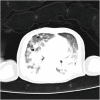Diagnosis and Surveillance of Neonatal Infections by Metagenomic Next-Generation Sequencing
- PMID: 35401464
- PMCID: PMC8989347
- DOI: 10.3389/fmicb.2022.855988
Diagnosis and Surveillance of Neonatal Infections by Metagenomic Next-Generation Sequencing
Abstract
Microbial infections cause significant morbidity and mortality in neonates. Metagenomic next-generation sequencing is a hypothesis-free and culture-free test that enables broad identification of pathogens and antimicrobial resistance genes directly from clinical samples within 24 h. In this study, we used mNGS for etiological diagnosis and monitoring the efficacy of antibiotic treatment in a cohort of neonatal patients with severe infections. The median age was 19.5 (3-52) days, median gestational age was 37.96 (31-40+3) weeks, and the median birth weight was 3,261 (1,300-4,300) g. The types of infectious diseases included pneumonia, sepsis, and meningitis. mNGS reported microbial findings in all cases, which led to changes in antibiotic treatment. These included cases of Mycobacterium tuberculosis, Legionella pneumophila, and Bacillus cereus. Eight of ten infants recovered after antibiotic adjustment and showed normal development during follow-up. On the other hand, neurological retardation was seen in two infants with meningitis. mNGS enabled etiological diagnosis and guided antibiotic therapy when all conventional methods failed to discover the culprit. It has the potential to cut down the overall cost and burden of disease management in neonatal infections.
Keywords: Bacillus cereus; Legionella pneumophila; Mycobacterium tuberculosis; metagenomic next-generation sequencing; neonatal infections.
Copyright © 2022 Zhang, Zhuang, Xiao, Li, Zhang, Huang, Zhang, Peng and Liu.
Conflict of interest statement
CL and C-yL were employed by Hangzhou Matridx Biotechnology Co., Ltd. The remaining authors declare that the research was conducted in the absence of any commercial or financial relationships that could be construed as a potential conflict of interest.
Figures





References
LinkOut - more resources
Full Text Sources

